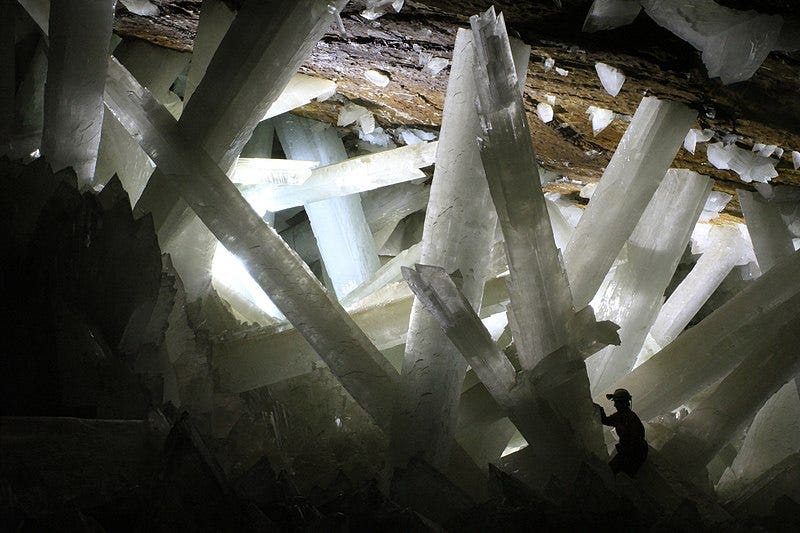Now that’s a crystal
I remember seeing in one of my geology classes this photo of the Cave of Crystals in Naica in Chihuahua State, Mexico.

The cave, discovered in 2000, is almost 1,000 feet deep. The crystals are up to 37 feet long and over 3 feet wide (look at the person in the lower right for scale) and are made of gypsum. The mineral, like salt, forms in environments with high rates of evaporation, like shallow seas, or in the case of the Cave of Crystals, in underground environments where the concentrations of calcium and sulfate in groundwater are high.
The cave sits on a fault line and above a magma reservoir buried 2 to 3 miles (3 to 5 km) beneath Naica. Roughly 26 million years ago, magma rose from this chamber, forcing mineral-rich waters upward through cracks in the rock. The scalding water opened caverns in the limestone and formed deposits that crystallized over thousands of years as it slowly cooled. Temperatures later stabilized at around 136 degrees Fahrenheit (58 degrees Celsius), creating ideal conditions for gypsum crystals to grow to mammoth proportions from a mineral called anhydrite.
For comparison, the following photo shows the size of the usual (handheld) sample of gypsum that I might have shown to my geology lab class.

I think that one of those 25-ton crystals on my lawn would be a better conversation starter.
A 6-inch UFC fighter

I would not want to be six inches tall and staring this mantis shrimp in the face. It looks like it has a chip on its shoulder. And when it rises into its threat display —

— it’s just creepy.
But it backs up its creepiness with “the strongest self-powered strike by an animal,” which enables the shrimp to crack shells (and drive off an octopus). The secret is its club-like front legs.
If threatened, the peacock mantis shrimp can whip out these appendages at speeds of 23 m/sec (75 ft/sec). That's 50 times faster than the blink of an eye, or about the same as the trajectory of a .22 calibre bullet – and with a force some 100 times that of its weight, making it the strongest self-powered strike by an animal.
But wait, there’s more!
The punch is so fast that it causes a cavitation bubble to form between the shrimp and its prey. The bubble forms because, for a split second, the space between the shrimp’s leg and the prey approaches a vacuum, which causes the pressure within the bubble to drop. And because the pressure drops, the water begins to boil. Here’s the kicker: the temperature of that water is as hot as the surface of the sun! Fortunately for all life on Earth, the bubble implodes instantaneously. The poor prey feels that implosion like another punch.
I could have used a 4-foot mantis shrimp as my best friend in junior high school. I might still have my lunch money.
Rats and climate change
Yep. No surprise here. Global warming is good for rats. Researchers looked at rat populations in 16 cities around the world.
Eleven of 16 cities (69%) had significant increasing trends in rat numbers, including Washington D.C., New York, and Amsterdam. Just three cities experienced declines. Cities experiencing greater temperature increases over time saw larger increases in rats. Cities with more dense human populations and more urbanization also saw larger increases in rats. Warming temperatures and more people living in cities may be expanding the seasonal activity periods and food availability for urban rats.
Of the 16 cities, 13 were in the United States; the other three were Toronto, Tokyo, and Amsterdam. The study attributed 40.7 percent of the variation among the cities to “the mean temperature increase a city had experienced relative to long-term temperature averages.” The study also noted that global warming is linked to the expansion of the ecological ranges of rats in China and New Zealand.
Given that the major emitters of carbon dioxide are not interested in slowing the process of global warming, much less stopping or reversing it, rat infestation will expand and intensify and pest management programs will require more funding and personnel. Somebody needs to talk to Trump.
Dad joke
Where do rich cows go for vacation?
Answer: Cape Cud.



I have a mom‘s joke, what do you call a mother cow that just gave birth? De-calf-inated. I know 🤦🏽♀️lol